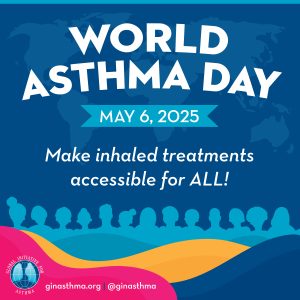World Asthma Day
Every year, the first Tuesday of May marks World Asthma Day. The theme of the day is making inhaled treatments accessible for ALL set by the Global Initiative for Asthma (GINA). It is one of the most common chronic non-communicable diseases that affects over 260 million people. It is responsible for over 450,000 deaths each year worldwide, with most of these deaths being preventable. This the important day is essential for both controlling the underlying disease and treating attacks. While it is often seen as a childhood or young adult condition, there’s a crucial group that’s frequently overlooked: older adults in care homes.
What is asthma?
It is a long-term condition that affects the airways in the lungs, making it difficult to breathe. Ranging from mild wheezing and coughing, to severe attacks that require emergency treatment, it can be triggered by many things including allergies, cold air, physical activity or stress. It continues to be under diagnosed and under treated, across the UK and worldwide.
In low-middle-income countries, lack of availability or high cost of inhaled medicines, especially inhaled corticosteroid-containing inhalers, are major contributors to the fact that 96% of global asthma deaths occur in these countries. Even in high income countries, high costs can mean that many people with asthma have limited access to essential inhaled medicines, resulting in poorly controlled asthma and preventable asthma deaths. – GINA
As we age, the diagnosis can be harder due to lungs becoming less elastic and the weakening in our immune response. In care homes, many residents already live with multiple chronic conditions such as heart disease or COPD (Chronic Obstructive Pulmonary Disease), asthma can be mistaken for other respiratory issues. Many older adults develop asthma later in life (late onset asthma) or live undiagnosed for years.
Managing the breathing condition is about more than just inhalers. It involves understanding the triggers people face including pollen, smoke or pets; following an asthma action plan; staying up to date with vaccinations and keeping environments clean, dust and smoke free.
Common Triggers in Elderly Care Settings
Certain environmental factors in care homes can worsen symptoms:
-
Dust mites in carpets or bedding
-
Mold in poorly ventilated areas
-
Strong cleaning chemicals or fragrances
-
Cold or dry indoor air
Even emotional stress or anxiety, common among older adults facing isolation, can trigger flare ups.


